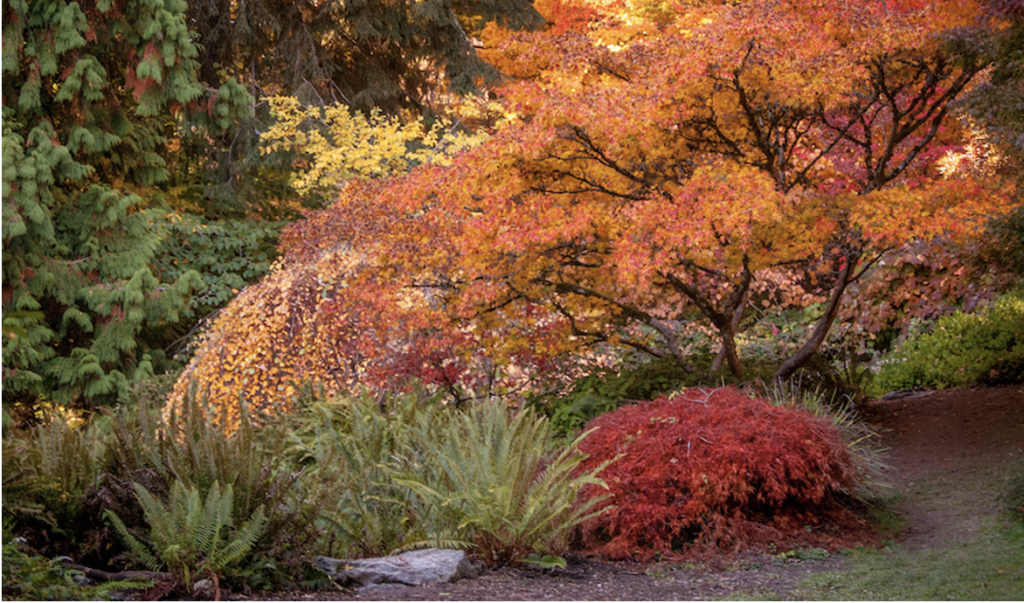-Pam Scott-

October skies are clear, the air is crisp, and it’s the perfect time to work in the garden. There are plenty of gardening chores to be done before we hang up our trowels for the winter. Fall crops need to be mulched, protected from frost, and harvested. Potted plants need to be trimmed, sprayed for bugs, and brought indoors for the winter. October is a wonderful time to plant fruit trees, strawberries, perennials, garlic, shallots, and spring flowering bulbs. Carrot and spinach seeds can be planted for early harvest in March. Pansy starts planted in October will get a jump on spring and can grow into healthy, full, and abundantly-flowering plants through the winter.
Many native and naturalized trees, shrubs, and perennials will naturally produce seeds that will fall to the ground in autumn. These seeds will stay cold and dormant until spring when the earth warms and the seeds burst into germination and growth. This cold dormancy period is called vernalization. Most seeds that you will want to plant in your garden, annual flowers, vegetables, and herbs, are native to warmer climates. They are planted in moist ground or seed pots in the spring and will germinate within a few days or weeks.
Some tree, shrub and perennial seeds, as well as bulbs, native to colder climates, will not germinate and bloom without a cold period to break their dormancy. Garlic, shallots, tulips, narcissus, hyacinth, fritillaria, allium and crocus can certainly be planted directly in the ground or in pots in October to wait out their vernalization. The only problem you may encounter is the squirrels relocating your tulips! I broadcast the seeds of chamomile, larkspur, cold climate poppies and wildflower meadow mixes in October with little-to-no germination issues.
Winter can expose other seed varieties to problems such as being eaten by critters and unpredictable weather conditions. Periods of warm weather in winter can stimulate dormant seeds to germinate only to be killed by the next freezing cold spell. Unseasonably warm winters may not be consistently cold enough to stimulate germination in the dormant seeds. It is also helpful to know exactly where your germinating seeds are so you don’t plant over them! For these reasons it is a good idea to start most native and other vernalizable seeds indoors. You can trick the seeds into thinking they have gone through winter by planting them in seed trays under humidomes and placing them in the refrigerator, above 32 degrees. If space is an issue, you can place the seeds between moist paper towels and seal them in silicone zip lock bags for their vernalization period. Keep the moist seeds from freezing, and don’t let them dry out. Be sure to look up how long each variety needs for its cold dormancy.
Vernalization needs can range from several weeks to months. Plan ahead and keep the dates on a calendar. After the predetermined vernalization period, treat your seeds like any other seedling. Plant your paper towel seeds into seed trays, or bring your already-planted seed trays out into a warm room. The seeds will think it’s spring; the warmth will stimulate germination. Place them under T5 fluorescent or LED grow lamps for supplemental lighting until they are ready to go outside.
When outdoor temperatures begin to warm up, you will want to acclimatize your seedlings to their permanent locations in the garden. Move them to a protected area or a cold frame for 2 weeks before planting them in the ground.
Although there are hundreds of perennials, trees and wildflower seeds that you can vernalize indoors I have had success with these varieties:
- Aquilegia
- Asclepias
- Baptisia
- Cimicifuga
- Red bud
- Echinacea
- Eupatorium
- Filipendula
- Mertensia
- Ratibida
- Tricyrtis
- Joe pye weed
- Thalictrum
You can trick your spring-flowering bulbs into blooming in the house in winter by indoor cold-chilling them as well. Plant grape hyacinth, crocus, narcissus, or tulips in a container filled with moist soil, cover well, and place in the refrigerator for 12 to 14 weeks; don’t let them dry out. Take them out after the prescribed dormancy period, place them in a warm sunny room, and they will think it’s spring. Paperwhites and amaryllis bulbs are native to warmer climates and do not need pre-chilling in order to bloom. Plant them in pots indoors from October through November for fabulous holiday and winter blooms.
Come by Fifth Season Gardening where you will find bulbs, seeds, soils, lights and a million other things to make your year round gardening adventures successful and fun!

Leave a Reply